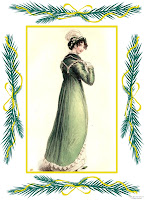I ran across this bit whilst reading Northanger Abbey with my budding Janeite:
“Although our productions have afforded more extensive and unaffected pleasure than those of any other literary corporation in the world, no species of composition has been so much decried. From pride, ignorance, or fashion, our foes are almost as many as our readers. And while the abilities of the nine-hundredth abridger of the History of England, or of the man who collects and publishes in a volume some dozen lines of Milton, Pope, and Prior, with a paper from the Spectator, and a chapter from Stene, are eulogized by a thousand pens–there seems almost a general wish of decrying the capacity and undervaluing the labour of the novelist, and of slighting the performances which have only genius, wit, and taste to recommend them.”
And I thought of it again at my friend Therese Walsh’s booksigning, where I found myself in an amicable debate with a stranger on the question of whether Jane Austen wrote literary or popular fiction. The other lady argued that of course Jane was literary, while I suggested that Jane was writing popular fiction of her time. Our discussion was pretty lively but we realized we didn’t have a good definition for what was literary versus popular, one that didn’t do injustice to one or the other.
I can’t remember all the ground we covered (I was drinking wine and enjoying myself) but here are some ideas I’ve seen or heard on the web and elsewhere. Please note I don’t necessarily agree with these definitions. Many are silly and I can come up with all sorts of counterexamples. Anyway, let’s see where Jane’s work fits.
The quality of writing is better in literary versus popular fiction.
I don’t necessarily agree, but by this rule Jane’s work is LITERARY.
Literary authors write for art’s sake; authors of popular fiction write for money.
I remember reading that Jane was glad that her earnings helped her family financially; on the other hand, profit wasn’t her sole motive. I’d say this test is inconclusive.
Literary novels are meant to elevate the mind; popular novels are meant to amuse.
Well, here’s another quote, from a letter Jane wrote to Mr. Clarke, librarian to the Prince Regent.
“I could not sit seriously down to write a serious romance under any other motive than to save my life; and if it were indispensable for me to keep it up and never relax into laughing at myself or at other people, I am sure I should be hung before I had finished the first chapter.
By this rule, I’d say Jane’s work is POPULAR.
Literary novels are good for you (like cod liver oil). Popular novels are what people actually want to read.
Easy answer here—Jane’s work is POPULAR.
Popular fiction is written to fit specific genre expectations, e.g. romance, horror, mystery. Literary fiction has no such constraints.
This is about the most sensible delineation I’ve seen anywhere. But back when Jane was writing, I think novels were novels and not pigeon-holed into genres the way they are now. And as the Northanger Abbey quote indicates, they weren’t as well-respected as other literary forms. So this test is inconclusive.
So much classic fiction fits well into modern genres. Novels by Jane Austen and the Brontes (romance/women’s fiction), Edgar Allen Poe (horror), Jules Verne (science fiction) are a few that come to mind. Which gets me to the next “rule”.
Literary fiction stands the test of time; popular fiction is ephemeral.
Not that I think this will be true (for instance, I think Harry Potter will endure) but in Jane’s case, this is a no-brainer. By this rule, her work is LITERARY.
So anyway, in this totally un-scholarly analysis, it comes to a tie. What do you think? Is Jane Austen’s work literary or popular? Or does her work transcend such categories?
Happy Birthday, Jane, and thanks for the hours of “extensive and unaffected pleasure”!
Elena

 Christmas is come and every hearth
Christmas is come and every hearth









